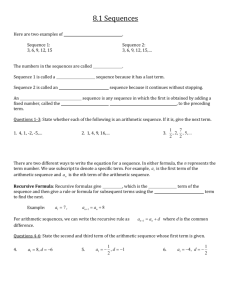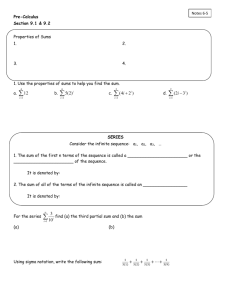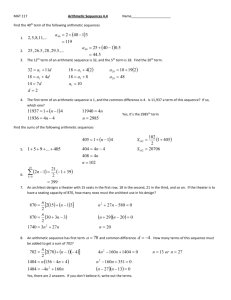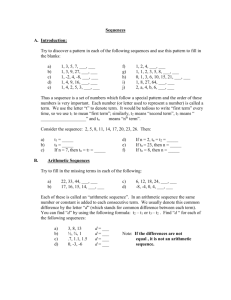Integrated 1
advertisement
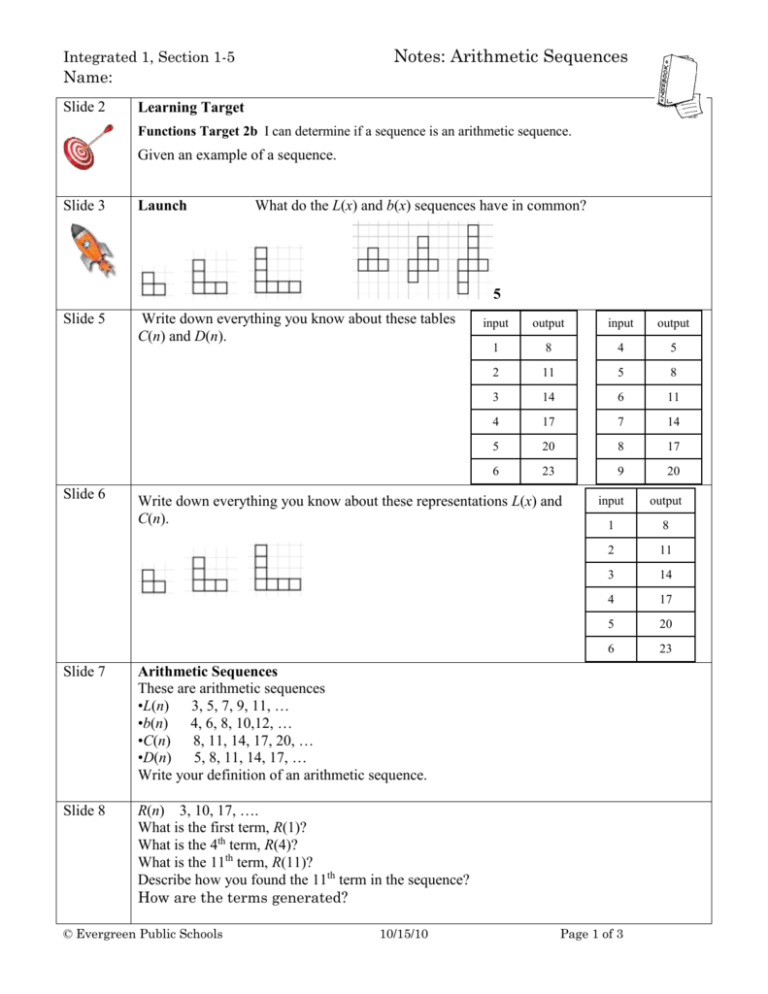
Notes: Arithmetic Sequences Integrated 1, Section 1-5 Name: Slide 2 Learning Target Functions Target 2b I can determine if a sequence is an arithmetic sequence. Given an example of a sequence. Slide 3 Launch What do the L(x) and b(x) sequences have in common? 5 Slide 5 Slide 6 Write down everything you know about these tables C(n) and D(n). input output input output 1 8 4 5 2 11 5 8 3 14 6 11 4 17 7 14 5 20 8 17 6 23 9 20 input output 1 8 2 11 3 14 4 17 5 20 6 23 Write down everything you know about these representations L(x) and C(n). Slide 7 Arithmetic Sequences These are arithmetic sequences •L(n) 3, 5, 7, 9, 11, … •b(n) 4, 6, 8, 10,12, … •C(n) 8, 11, 14, 17, 20, … •D(n) 5, 8, 11, 14, 17, … Write your definition of an arithmetic sequence. Slide 8 R(n) 3, 10, 17, …. What is the first term, R(1)? What is the 4th term, R(4)? What is the 11th term, R(11)? Describe how you found the 11th term in the sequence? How are the terms generated? © Evergreen Public Schools 10/15/10 Page 1 of 3 Integrated 1, Section 1-5 Notes: Arithmetic Sequences Slide 9 R(n) 3, 10, 17, …. In this sequence, when you subtract a term from the next term, you always get ____. Slide 10 ____ is the _______________________________________ in this sequence. Write an equation that can be used to find a term in the sequence when you know the term that came before it, R(n). th Write an equation that can be used to find the n term in the sequence, R(n). Slide 11 Slide 12 Slide 13 The equation that can be used to find a term in the sequence when you know the term that came before it, R(n), is: R(n) = ___________________+ __________________________________ This is called a recursive equation. Verify that your equation generates your sequence. th The equation that can be used to find the n term in the sequence. R(n) = ___________________+ ________________________________________________ Slide 14 Slide 15 This is called an explicit equation. Verify that your equation generates your sequence. Is the sequence, R(n) 3, 10, 17, …. a function? Justify your claim. If it is, what’s the input? the output? Slide 16 Slide 17 Team Practice For each sequence Find the 4th term in the sequence. Find the 11th term in the sequence. Write an equation that can be used to find the nth term in the sequence. 7, 12, 17, …. 27, 23, 19, … I’m thinking of a new sequence. The 4th term in the sequence is 27. The 10th term in the sequence is 51. © Evergreen Public Schools 10/15/10 Page 2 of 3 Integrated 1, Section 1-5 Notes: Arithmetic Sequences •Find the common difference. •Find the first term in the sequence. •Find the equation of the arithmetic sequence. Slide 18 Team Practice A new sequence T(11) = 42 T(21) = 77 Find T(1) Find T(x) Slide 19 Debrief Are arithmetic sequences functions? How do you know? Slide 20 Did you hit the target? I can find the equation or specific terms of an arithmetic sequence. Slide 21 Rate your understanding of the target from 1 to 5. Practice Practice 1.5A Arithmetic Sequences © Evergreen Public Schools 10/15/10 Page 3 of 3


